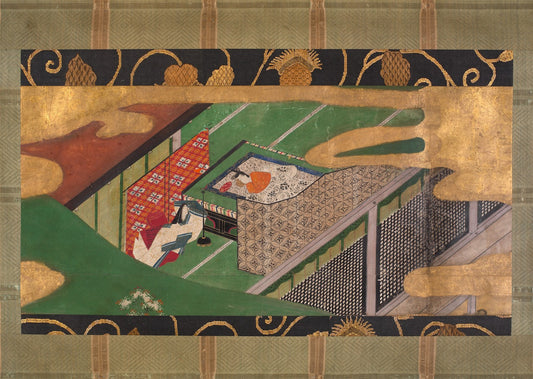Feature image: Amphora with Ajax Carrying the Dead Achilles via The Walters Art Museum
Black Amphora Art
Pottery is more than just a dish you would find in your kitchen. Pottery itself is an art form representing artists in their generations respectfully. In Ancient Greece, artists were known for black-figure amphora art, which was a piece of pottery with a black glaze over the topic, giving a name to an image. The Greeks, typically Athenians, had a theme of depicting nudity in men and stories from Greek mythology. Famous characters such as Achilles, Ajax, Theseus, and the minotaur were depicted on black figure amphoras.
Interestingly, there aren’t many women portrayed, but if there are, they're clothed. Black-figure amphora art gave insight into narratives of Ancient Greece and the mythology stories that were shared. Thus, it was an honor of ancient customs in Greece.
What is black-figure amphora art?
Amphoras all together were popular items used by the Greeks. Although an amphora looks like a vase, it wasn’t used as one. Rather, an amphora was a piece of potter that came out as a two-handled jar used for serving wines and oils. Also, the name “black figure” comes from the “black silhouettes set against the color of the clay beneath, which, in Athens, was a red-orange color.” Typically, amphoras, like any kind of pottery, were made of clay. However, the Greeks had a specific process of how to create them. Greek potters started with “procurement of the clay” before mixing, which was known as levitation when the clay was mixed with water. Then, potters used a potter wheel to wedge an air bubble out of the clay and form the vase shape for the amphora. Potters used both hands to do so, just as artists still do to this day while using a pottery wheel. Thus, black-figure amphoras were often gifted to winners at the Olympics. According to the Department of Classics, black figure techniques of amphora came about “in the city of Corinth around 700 B.C.E.” Although it started with the Corinthians, the Athenians adopted the black-figure technique shortly after for their amphoras.
Achilles and Ajax Playing a Board Game
Achilles and Ajax Playing a Board Game are a good example of a black-figure amphora. The amphora features two famous favorites from Greek mythology, Achilles and Ajax. Both men are featured in Homer’s The Iliad, and on the amphora, they’re both playing a board game during the Trojan War. The fictional world they both fought in and died in. According to ArthistoryResources, the writers acknowledge how both men are armed and are holding spears. However, instead of doing their heroic deed of fighting in the Trojan War, “Achilles and Ajax are neglecting their duties and irresponsibly play at a board game.” The artist of this specific black amphora art is Exekias. He was a potter and a painter, and he signed this black amphora. Just by looking at the amphora, viewers can tell the ages of both men. Achilles is much younger, wearing a helmet on the left-hand side, while Ajax is not wearing a helmet and sitting on the right-hand side. It’s implied through the helmet wearing that Achilles will win, as he was the Greeks' greatest hero before Hector killed him. Meanwhile, Ajax committed suicide. Ironically, this is a completely different undertone from the picture Exekias painted.
The Panathenaic prize amphora
Another famous black-figure amphora is The Panathenaic Prist Amphora, also known as the Panathenaic Games. Unlike the amphora of Achilles and Ajax, this black-figure amphora has a touch of terracotta. The artist is Euphiletos, who created this amphora in 530 BC, which was near the end of the Archaic Period of Greece. The picture he depicted does not follow Greek mythology or a narrative. Rather, it shows a group of men running in the nude. The closer viewers look, they’ll notice all the men in the image have a beard except one man in the back. Traditionally, in Ancient Greece, beards emphasized attractiveness and age for men. In the image on Euphiletos’s black amphora, the men more than likely were participating in the Olympics, as they’re nude. Only men competed in the Olympics, and they did so in the nude. So, this amphora is history-based.
Theseus Slaying the Minotaur
Lastly, the black-figure neck amphora is called Theseus Slaying the Minotaur. The black silhouette image depicts another Greek mythology hero, Theseus, who famously slayed the minotaur, a half-man and half-monster creature. The closer viewers look, the more they’ll see Theseus, the minotaur, and additional characters, such as a woman and a man, on either side of the amphora. Yes, Theseus and the Minotaur are the main subjects, just like the classic narrative. However, the additional characters are also a part of their narrative. For instance, the woman is Aridane, the princess of Crete, who helped Theseus. The man on the right is an unnamed Athenian man. All the characters in the painting have clothes on. In addition, the amphora itself has two handles and a ceramic piece of pottery.
Altogether, the black-figure amphora art strongly illustrates Ancient Greece. They had multiple purposes, serving wines and oils at gatherings and honoring Greek heroes and characters. Centuries later, the black-figure amphora pottery is an artifact of Ancient Greece and Greek mythology.
©ArtRKL™️ LLC 2021-2024. All rights reserved. This material may not be published, broadcast, rewritten or redistributed. ArtRKL™️ and its underscore design indicate trademarks of ArtRKL™️ LLC and its subsidiaries.









